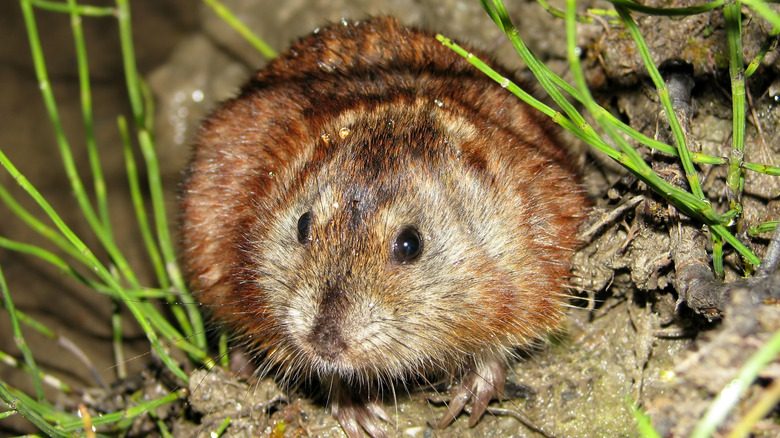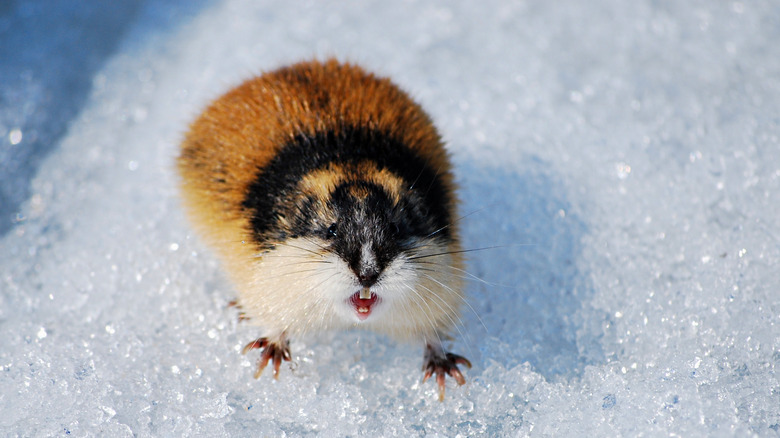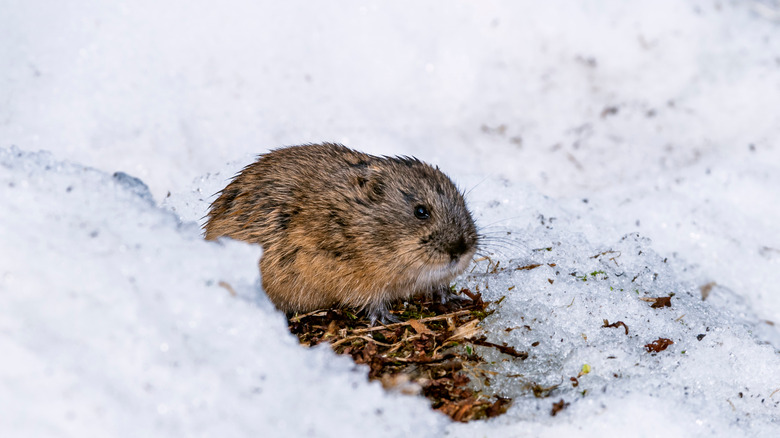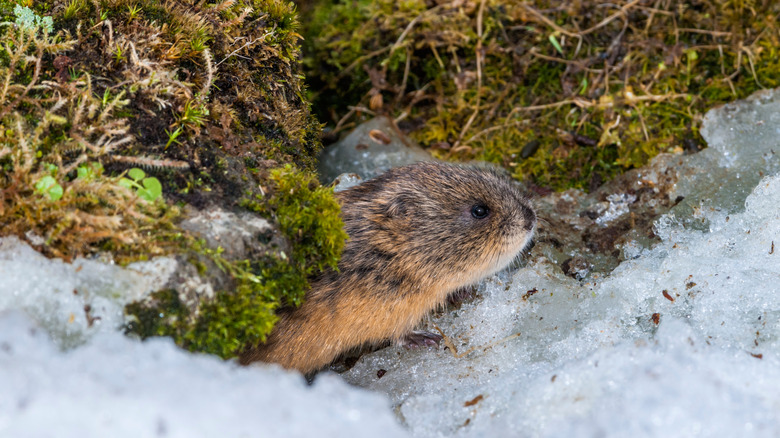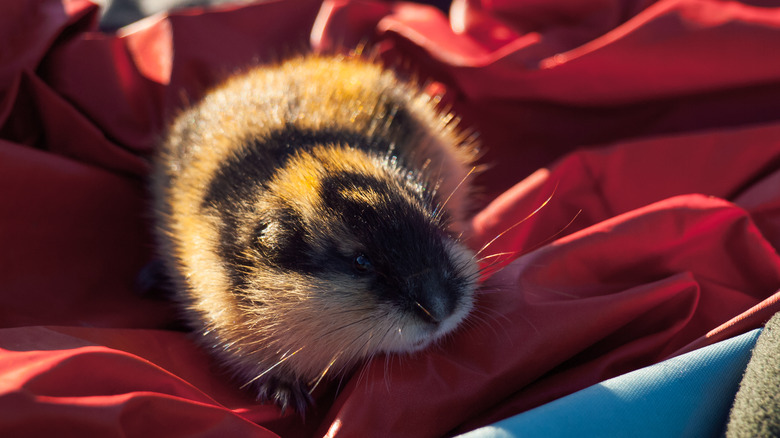Will Lemmings Really Follow Each Other To Their Deaths?
Lemmings may appear to be rather small and unspectacular creatures. According to Britannica, there are 20 species of these adorable little rodents, the smallest of which (a dubious joint honor held by the steppe and wood lemming) generally weighs no more than one ounce and seems to top out at 4.7 inches long.
These furry critters are surprisingly resilient, making homes in areas of difficult terrain, such as the inhospitable tundra of the Arctic. They're closely related to voles and muskrats, according to Britannica, and seem to be as unassuming as guinea pigs. Nonetheless, they have become popular culture mainstays, even appearing in the video game series "Lemmings," a fascinating puzzle experience in which the player must guide these bumbling creatures through levels and protect them. The robe-clad lemmings of the games, it seems, have no survival instinct at all, and will simply walk over cliffs to their deaths or blunder into other hazards. Real lemmings, it seems, aren't nearly so impetuous.
The great lemming mystery
The animal kingdom is truly full of wonders. Humankind might have an elevated opinion of its own importance and superiority, but we share our planet with animals that can run faster and jump higher than we can, as well as being stronger, more resilient and, sadly, a great deal more compassionate and cooperative than we tend to be with each other.
There are certain legends about fascinating creatures from around the world that we take for granted. One very common example has to do with lemmings, and the idea that lemmings will charge over cliffs to their deaths, each obliviously following their companions in front.
This has come to be interpreted as a fact, just another example of animal behavior that can't quite be explained. According to Mental Floss, though, lemmings will not instinctively do this. The idea that they engage in something like mass suicide seems to have developed from a rather dark 1958 nature documentary made by family-friendly funsters Disney.
A Disney documentary popularized the belief
In the live-action documentary "White Wilderness Part II: The Lemmings And Arctic Bird Life" (via complience on YouTube), the narrator begins by sharing the popular belief that great groups of lemmings will run over cliffs into the ocean to their deaths. The documentary states that this is "a story both true and false," though, it would seem, it later proved to be primarily false.
The documentary shows countless little furry critters running toward the cliff edge, "creating tiny avalanches of sliding soil and rocks" as they go, before casting themselves over the edge. As dramatic music plays, the narrator claims that the lemmings "seem to survive their ordeal," before proceeding to swim "away from shore toward the far horizon."
The narrator concludes that "it's not given to man to understand all of nature's mysteries," postulating that the lemmings may instinctively be trying to reach a further shore. Per the Alaska Department of Fish and Game, though, the supposed event was actually contrived for the documentary. Camera tricks and lemmings running on a disguised turntable in Canada's Alberta (which does not have ocean access and isn't a native home of lemmings) resulted in this part of the documentary, it's claimed, and lemmings were reportedly actually herded over the edge of the cliff during the making of the film. They weren't following each other instinctively.
The reason for mysterious migrations
"White Wilderness" popularized the myth that this was standard lemming behavior, per How Stuff Works, but it was referencing a belief that already existed. In 2020, the Arctic University of Norway's Rolf Anker Ims, who studies the biology of the region, suggested to How Stuff Works that "this idea stems from the migrations observed in one lemming species: the Norwegian lemming ... during the peak years of this species, a large number of individuals migrate out of their normal habitat and die in large numbers." Ims went on to state that research hasn't found a conclusive reason for this behavior, noting that "social stress, food shortage or predators are candidates."
The Alaska Department of Fish and Game reports that University of Alaska Fairbanks zoologist Gordon Jarrell expanded on this, calling the phenomenon "mass dispersal." Jarrell explained that lemmings are a great example of it, having been documented as traveling in vast groups in a "pretty directional" way to a great expanse of water. Great numbers of them will gather by the edge of the water, before attempting to cross.
"If they get wet to the skin, they're essentially dead, " Jarrell bluntly concluded. It seems, then, that the truth is quite the opposite of the tale: lemmings aren't trying to die. They're trying to live.
Norwegian lemmings are the really adventurous ones
Britannica states that lemming populations can be very unpredictable. In the specific cases of the brown and collared lemming, there are cycles of between two and five years in which populations reach record highs. As biological researcher Ims suggested to How Stuff Works, these are the times when lemmings seek to migrate.
The difference between the Norwegian lemming and other species, per Britannica, is that the former tends to venture much further afield. In their tundra home, the further they venture, the more danger the little furballs expose themselves to, and this can account for the high numbers of deaths among migrating Norwegian lemmings. Britannica goes on to say that a particularly large-scale migration takes place around once every 30 years, in the Lapland region, within the Arctic Circle. The lemmings do, it seems, travel by dark at first so as to avoid predators and other dangers, but huge masses of them have also been known to travel during the day.
